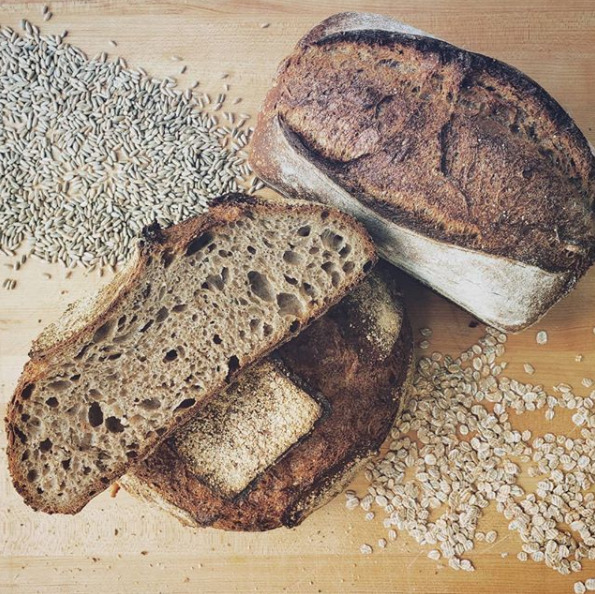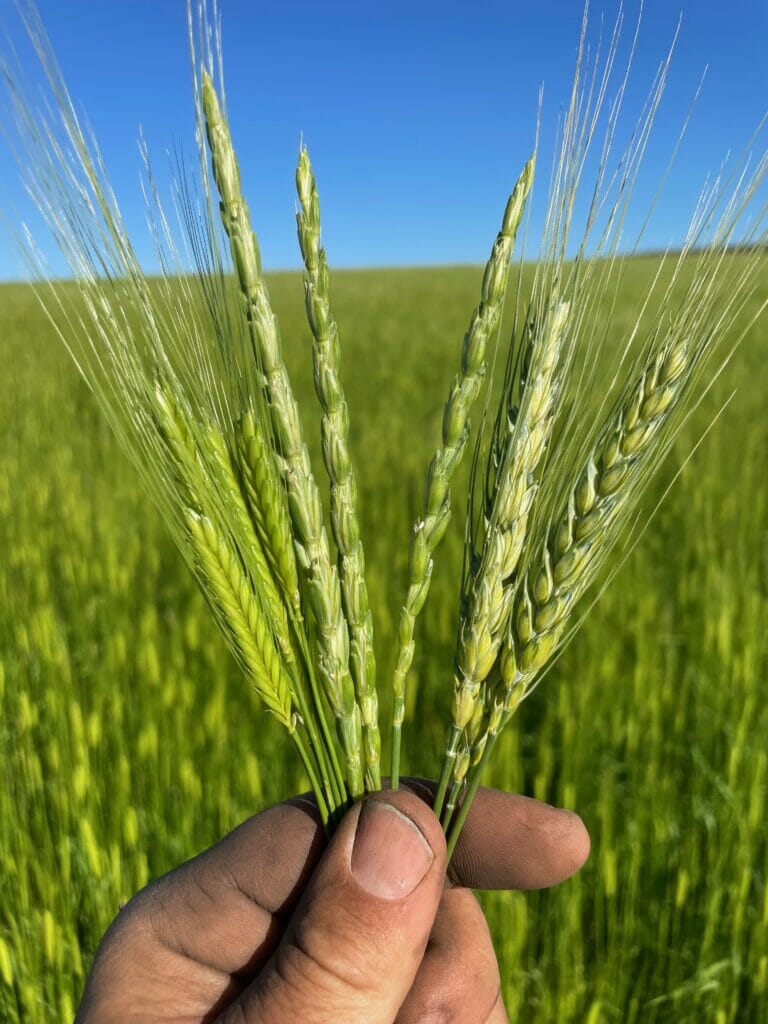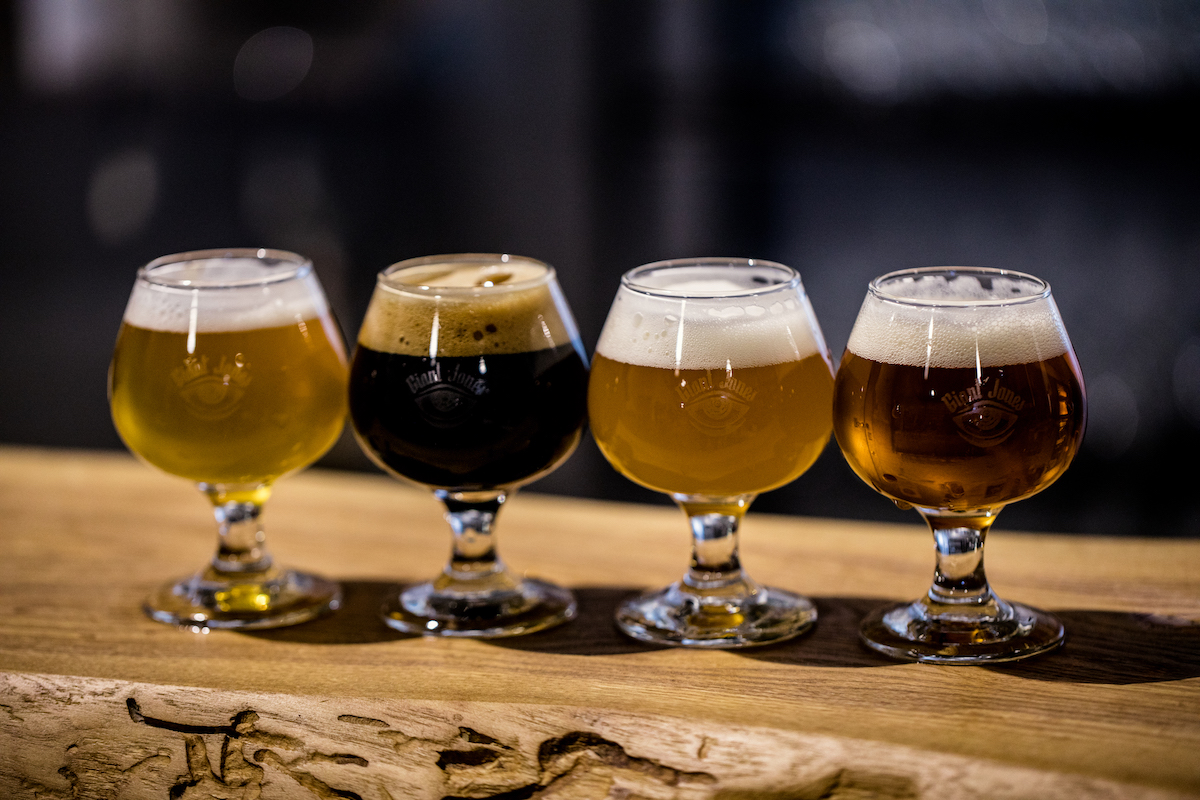Meet the Midwestern Bakers and Farmers Working to Rebuild a Local Grainshed
Artisan Grain Collaborative, a network of farmers, millers, maltsters, brewers, bakers and distillers, is fostering a resilient and equitable regional breadbasket.
Meet the Midwestern Bakers and Farmers Working to Rebuild a Local Grainshed
Artisan Grain Collaborative, a network of farmers, millers, maltsters, brewers, bakers and distillers, is fostering a resilient and equitable regional breadbasket.

A regional grain-containing loaf from AGC member Bird Dog Baking in Ypsilanti, MI.courtesy of Artisan Grain Collective.
Buckwheat chocolate croissants at Publican Quality Bread, loaves of sunflower rye and limpa bread at Lost Larson, sourdough muffins, cookies and seeded sourdough breads at Floriole and pie crusts and biscuits at Baker Miller are just a few delicious examples of locally grown and stone milled grains now prevalent in Chicago.
These pioneering bakers, who believed in the quality and integrity of local grain and locally milled flour, were founding members of what has become the Artisan Grain Collaborative (ACG). The network of 180 farmers, millers, maltsters, bakers, chefs, food manufacturers, brewers, distillers and researchers across the Upper Midwest are dedicated to building a diverse regional grain shed built on regenerative agriculture practices. The largest concentration of members is located in Illinois, Minnesota, Michigan and Wisconsin. There are also members in Iowa, Ohio, Indiana and Missouri.
Grain eaten in the Midwest comes from all over the place: Some is grown locally in the Great Plains, some is from western states and plenty of it comes from Canada and Europe. AGC was created to solve two interconnected challenges: the dominance of corn and soy agriculture in the Midwest and limited options available for diversifying those rotations; and the absence of locally grown and milled flours geared toward artisan bread production. Growing grains for food locally gives farmers opportunities to diversify their crop rotations, which brings about all sorts of soil, biodiversity and water quality benefits. Plus, having a local source for grains offers big economic opportunities for the region in both rural and urban communities, and it provides greater resilience in times of national or global supply chain disruptions.

“We felt passionate about supporting the local grain economy, but [we] felt like our customers and the industry as a whole didn’t understand it and didn’t want to adopt it because it cost too much or because the quality of the grain was too inconsistent for commercial application,” says Baker Miller’s Dave Miller about the genesis of AGC in 2016. It all started organically as a conversation between passionate bakers and partners such as Fresh Taste, Delta Institute and Kendall College.
Executive director Alyssa Hartman joined AGC in 2019 as the first full-time staff member. Since then, the community has more than quintupled. “When I started, there were very few farmers engaged in the network,” she says. “Bakers and end users wanted to pull the farmers along. That paradigm within our organization has really flipped on its head. The farmers in a lot of ways are the ones that are driving the ship now. That’s really important—that the people growing the food are leading and telling the rest of the community what it is that they need.”
The organization is comprised of five member-led working groups: education and outreach; research and variety testing; farmer collaboration; brewing and distilling; and institutional procurement. “We have genuine representation from all different aspects of the grain production system,” says Hartman. “We have all the people in the room—including the maltsters and millers—and it really is a stakeholder-led initiative”

Less than half of the farms in AGC’s network are certified USDA organic, but they are working directly with millers, bakers, chefs, brewers and distillers and have relationships where they can talk to customers about their growing practices.
For example, Luke Peterson at A-Frame Farms in Madison, Minnesota has a nine- to 12-year crop rotation—much longer than most Midwestern farms—that includes alfalfa, sunflowers, flax, barley, buckwheat, corn and spring and winter wheat. “Having consumers and buyers educated on alternative crops is really important because, without having a market for these, it’s not possible for farmers to grow them,” he says. “Diversity is key to [keeping] a healthy ecosystem functioning properly.”
For Claire Smith, a farmer, grain processor and food manufacturer of teff granola at Teffola, joining AGC encouraged her to take sustainable practices even further. “Our farm was already practicing regenerative agriculture when we joined AGC, but now we are going a bit deeper,” she says. “For example, we help stop soil erosion near water sources using a sod program, and we’re evaluating whether prairie stripping with perennial grasses and wildflowers might be a good option for us after I learned about prairie stripping at an AGC-organized event.”
Even during the pandemic, AGC has continued to grow, spurred by successful initiatives such as Neighbor Loaves, which provides freshly baked bread made with locally grown stone milled flour to local food pantries. Consumers can purchase these loaves at their local bakeries to feed neighbors in need.
Since launching in March 2020, Neighbor Loaves has distributed more 30,000 loaves to communities in need.

Over the next few years, AGC aims to engage more on policy education and build visibility among consumers for diversified grain systems. For example, a recent bill signed in Michigan incentivizes craft distilleries to use more Michigan-grown grains in their mash bill and, in turn, supports Michigan grain farmers. Another primary goal is to accelerate the growth of regional supply chains and collect data on the state of regional grains in the Midwest, which will be shared openly among members to facilitate collaboration.
“The connections and networking have been extremely beneficial for us as we grow our specialty grains cleaning and processing business,” says Smith. “We’re looking to stabilize our farm revenue by providing a service for farmers who have to be gluten free. Being able to talk with other farmers and processors about what has worked for them or resources they’ve tapped into has been helpful, especially since this is our first venture into food grade grains.”
As anyone working in agriculture and food policy knows, it can take months or even years to enact big changes—but it’s essential labor. “We’re working to create a community-based alternative to a commodity system,” says Hartman. “We want to foster a system where more of our grain-based food dollars are going into the pockets of farmers and makers, where more of our landscape is producing food that fosters greater regional resilience in a changing climate and where we prioritize ecology and people over simplicity and business as usual.”
Follow us
This work is licensed under a Creative Commons Attribution-NoDerivatives 4.0 International License.
Want to republish a Modern Farmer story?
We are happy for Modern Farmer stories to be shared, and encourage you to republish our articles for your audience. When doing so, we ask that you follow these guidelines:
Please credit us and our writers
For the author byline, please use “Author Name, Modern Farmer.” At the top of our stories, if on the web, please include this text and link: “This story was originally published by Modern Farmer.”
Please make sure to include a link back to either our home page or the article URL.
At the bottom of the story, please include the following text:
“Modern Farmer is a nonprofit initiative dedicated to raising awareness and catalyzing action at the intersection of food, agriculture, and society. Read more at <link>Modern Farmer</link>.”
Use our widget
We’d like to be able to track our stories, so we ask that if you republish our content, you do so using our widget (located on the left hand side of the article). The HTML code has a built-in tracker that tells us the data and domain where the story was published, as well as view counts.
Check the image requirements
It’s your responsibility to confirm you're licensed to republish images in our articles. Some images, such as those from commercial providers, don't allow their images to be republished without permission or payment. Copyright terms are generally listed in the image caption and attribution. You are welcome to omit our images or substitute with your own. Charts and interactive graphics follow the same rules.
Don’t change too much. Or, ask us first.
Articles must be republished in their entirety. It’s okay to change references to time (“today” to “yesterday”) or location (“Iowa City, IA” to “here”). But please keep everything else the same.
If you feel strongly that a more material edit needs to be made, get in touch with us at [email protected]. We’re happy to discuss it with the original author, but we must have prior approval for changes before publication.
Special cases
Extracts. You may run the first few lines or paragraphs of the article and then say: “Read the full article at Modern Farmer” with a link back to the original article.
Quotes. You may quote authors provided you include a link back to the article URL.
Translations. These require writer approval. To inquire about translation of a Modern Farmer article, contact us at [email protected]
Signed consent / copyright release forms. These are not required, provided you are following these guidelines.
Print. Articles can be republished in print under these same rules, with the exception that you do not need to include the links.
Tag us
When sharing the story on social media, please tag us using the following: - Twitter (@ModFarm) - Facebook (@ModernFarmerMedia) - Instagram (@modfarm)
Use our content respectfully
Modern Farmer is a nonprofit and as such we share our content for free and in good faith in order to reach new audiences. Respectfully,
No selling ads against our stories. It’s okay to put our stories on pages with ads.
Don’t republish our material wholesale, or automatically; you need to select stories to be republished individually.
You have no rights to sell, license, syndicate, or otherwise represent yourself as the authorized owner of our material to any third parties. This means that you cannot actively publish or submit our work for syndication to third party platforms or apps like Apple News or Google News. We understand that publishers cannot fully control when certain third parties automatically summarize or crawl content from publishers’ own sites.
Keep in touch
We want to hear from you if you love Modern Farmer content, have a collaboration idea, or anything else to share. As a nonprofit outlet, we work in service of our community and are always open to comments, feedback, and ideas. Contact us at [email protected].by Amber Gibson, Modern Farmer
October 26, 2022
Modern Farmer Weekly
Solutions Hub
Innovations, ideas and inspiration. Actionable solutions for a resilient food system.
ExploreExplore other topics
Share With Us
We want to hear from Modern Farmer readers who have thoughtful commentary, actionable solutions, or helpful ideas to share.
SubmitNecessary cookies are absolutely essential for the website to function properly. This category only includes cookies that ensures basic functionalities and security features of the website. These cookies do not store any personal information.
Any cookies that may not be particularly necessary for the website to function and are used specifically to collect user personal data via analytics, ads, other embedded contents are termed as non-necessary cookies.
Indian Government led by Prime Minister Mr. Modi has successfully convinced United Nations ( UN ) with support from 72 countries to declare 2023 as International Year of Millets, which shall increase awareness and consumption of Millets in a massive way worldwide, thereby increasing incomes of small farmers, increase farming of Millets / Ancient Grains which sequester more CO2 and consume less water than other Grains, gives tremendous health benefits to all Humans , especially diabetics and Aneamic patients and thereby save healthcare costs, worldwide. #MilletsofIndia
Love your article!